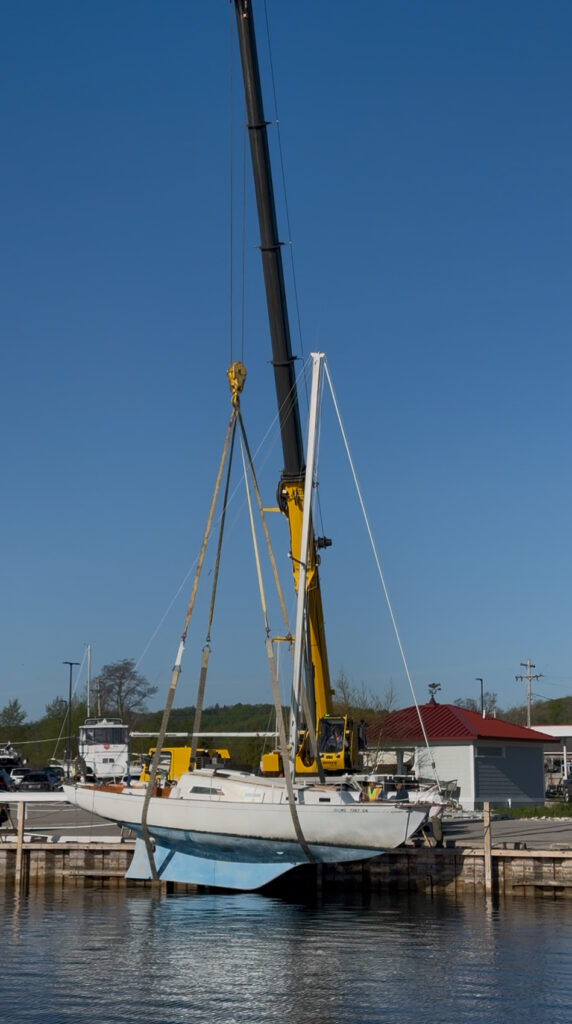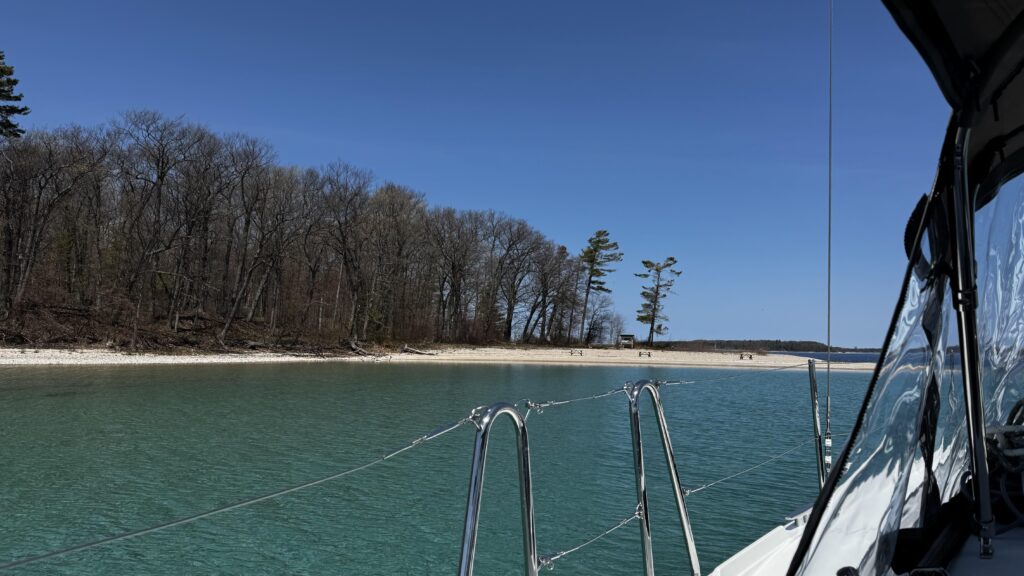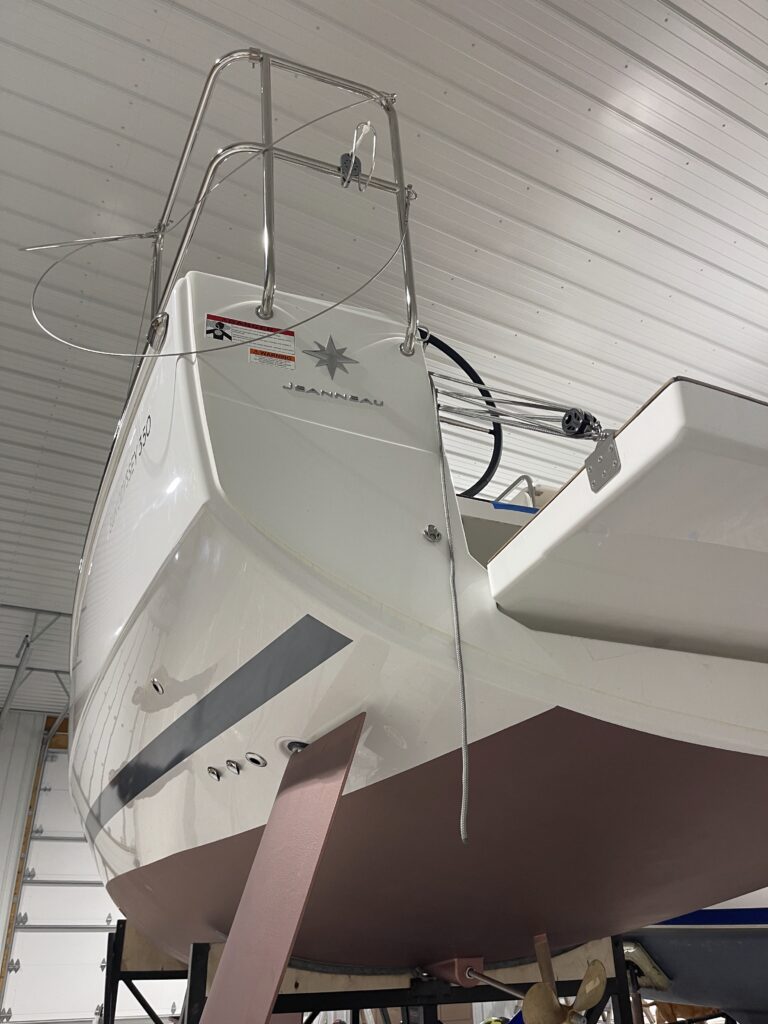We drove up to Traverse City on Friday to take our ASA training through Great Lakes Sailing. Since it was early May, we were definitely in the pre-season for sailing in the bay. The team at GLSC was in the middle of dropping boats in the water – big and small. Nautical Heeler was not in the water yet so the plan was to use a training boat for our training and to sleep on a different boat. Hopefully we would be able to board her by mid-week if everything went well.
Launching a boat
The process for getting Coelum (our old Starwind 22) in the water was pretty easy because of all of the help. From the East Harbor parking lot a group of Rocky Fork Sailing Club volunteers worked on the boats to step the masts. On a good day, we launched 10-12 boats. Sailboats of around 25 feet or less took 2 or 3 people on the boat to raise the mast. Another 2 or 3 on land assisted via some repurposed halyards. Start to finish was about 2 hours. Larger boats required a fixed crane because of the weight of the masts. Those tended to take longer. Once the masts are in place, the boats are backed down the launch ramp and floated. They then go out into the lake for a season of sailing.

Launching for Grand Traverse Bay usually involves a crane. A sling is placed around the hull of each boat and it is lifted off of its jack stands and lowered into the water. If the mast was taken down at the end of the last season – or the boat is new like ours – the same crane is used to step the mast while the boat sits in the water.
The boats in the bay are larger than those of our old lake – some nearly twice as long. A 22-footer like Coelum weighs on the order of 2,500 pounds. The largest boats can weigh up to 8,000 pounds. Our Sun Odyssey 350 weighs in at over 12,000 pounds and some of the boats top out at over 40,000.
Hello Nautical Heeler!
We were about 2 hours outside of Traverse City when Lucy at GLSC told us there was a change of plans. They had launched our boat and we would be spending the whole week on Nautical Heeler. She was docked in slip #20!

We spent the night sleeping in the v-berth in our sleeping bags. While the boat has heat, we chose to “rough it” and leave the hatch open. Word of advice: upper Michigan in May is not nearly as warm as southern Ohio. Close the hatch and don’t worry about packing shorts.
Training begins…
Our sailing instructor Loren stepped aboard on Saturday at 9 AM. The weather was a bit imposing for our first day but we nonetheless got right at it. Loren took us on a tour of our boat – opening all of the lockers, pulling up the floor boards, flipping the switches to see what they did… THIS was why we wanted to take the class on our own boat.
We left the dock and spent the morning getting an understanding of how to use the diesel engine. We motored south in West Grand Traverse Bay down to the Clinch Marina. There we practiced docking (with no boats around). Becky and I both tried our hand on docking bow first and then stern first. The bow first approach is easier but we will probably always take the harder approach of backing into the slip.
After about an hour, Loren took pity on us. We returned to Center Pointe where I did my first attempt at a 3-point turn to back into our slip. Not a rousing success, but with some dock-side help, I got her into place. It might have taken more than one attempt.
After lunch it was back out to finally raise the sails. There are far more lines on Nautical Heeler than on Coelum (no surprise there). Loren helped us sort it all out and with me at the helm, Becky and Loren unfurled the mainsail and jib. The winds were running about 12-16 knots and we easily got going at 6 knots SOG (speed over ground). The boat had no trouble as the lake was fairly flat with just the smallest of white caps. We had a super blast practicing our points of sail for a couple of hours.
Day 1 was a tremendous success. Time to study for the 101 test tomorrow.
Day 2
The winds were much gentler today and the sun came out. With the better weather we ran through some anchoring drills. We dropped anchor on a sandy flat and picked up a mooring ball in a nearby marina. The water of Grand Traverse Bay is crystal clear with visibility of nearly 20 feet. That and the site lines on the 350 make all of this easy to do, but we still need to figure out our hand signals. It won’t always be possible to see the bottom.
Power Island
Loren then had us sail to Power Island to anchor, take our ASA 101 test, and have lunch. We first started looking to take the ASA training in 2021 after we bought Coelem. We were scheduled to take it out of Stock Island in the Keys and prior to going there spent weeks studying for it. When we rolled up to the dock for the Southern Most Sailing School, there was a small craft advisory and they were forced them to cancel the class.

The 4 years since then provided enough real-world experience to make it all more familiar. A big help was deciding to participate in the races at Rocky Fork last year. There was still a ton of technical verbiage to absorb for this pass, but we had places to file it all now.
The test was a good measure of basic sailing knowledge and we both passed with high marks. Loren (and the last 4 years) had prepared us well.
After lunch, Becky took us back to the marina. The wind had died, so it involved a good deal of motoring, but we were still on the water.
It was probably a good thing that our first day had more intense weather than our second. If day one was “easy”, we might have gotten a sense of overconfidence that the stronger winds would have blown when they came. Now on to ASA 103…

